This is a Thorough Look at Every Kitchen Cutlery Series and Knife Set Zwilling Makes Right Now
Zwilling is the other staple of German kitchen knives. They feel like the Pepsi to Wusthof’s Coca Cola.
Or maybe it’s the other way around. I can never remember which one is more popular these days.
The point is that Zwilling has been a reliable knife maker since the 18th century, and they offer a massive line up of knives in these modern times. We’ve tested a few ourselves, but they currently make 16 distinct designs of knife sets, and that’s not including all the stuff they make strictly under the Henkels and Miyabi brands.
So this article lays out all their different kitchen knives and explains what makes one different from the other. I don’t try to rate them, but I do my best to explain where they fit in terms of budget and function.
Questions Worth Asking
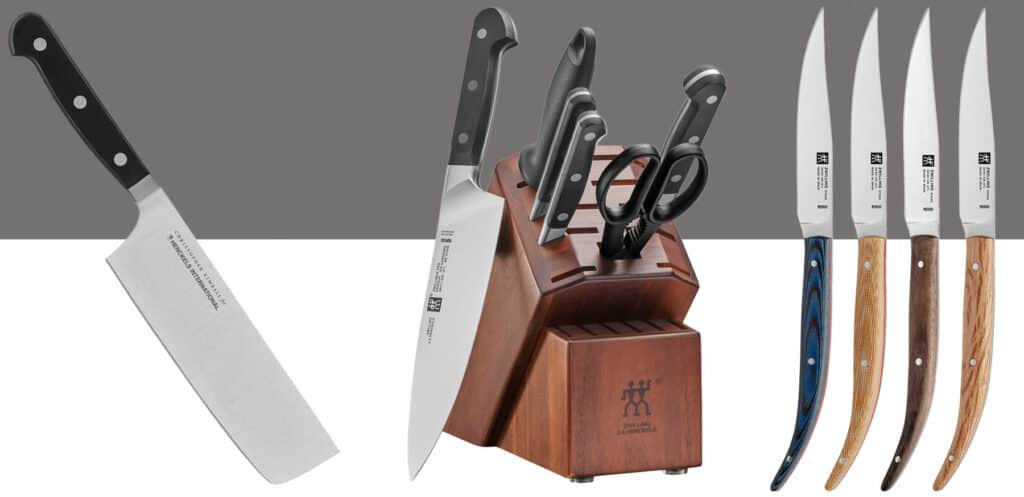
I always have a lot of my own questions when I start one of these guides, and I try really hard to either find the answer or find the reason I can’t find an answer. Here’s what I came into this wondering.
Do all Zwilling blocks fit all Zwilling Knives?
No they don’t, although they do have some one-size-fits-most options. A lot of it has to do with the shape and size of the bolsters, so you can make most knives with a flat-topped bolster work in standard blocks that have flat tops.
There are blocks with angled tops that are meant to fit knives with angled bolsters like the Pro and Twin Fin II. There are also options like the magnetic blocks and strips, or the in-drawer organizers that work with any kind of kitchen knife. It’s just a matter of choosing what works best in your kitchen, and what your knife bolsters will match up with.
Do they all use German steel?
Almost all of Zwilling’s kitchen knives use their own proprietary steel which was developed in Germany, but has since been delegated to… somewhere else. I haven’t found a firm source on that. But it’s still German in spirit. Their other knives use a smattering of decent Japanese, Swedish, and American steels for particular designs.
What Does the “Twin” designation mean?
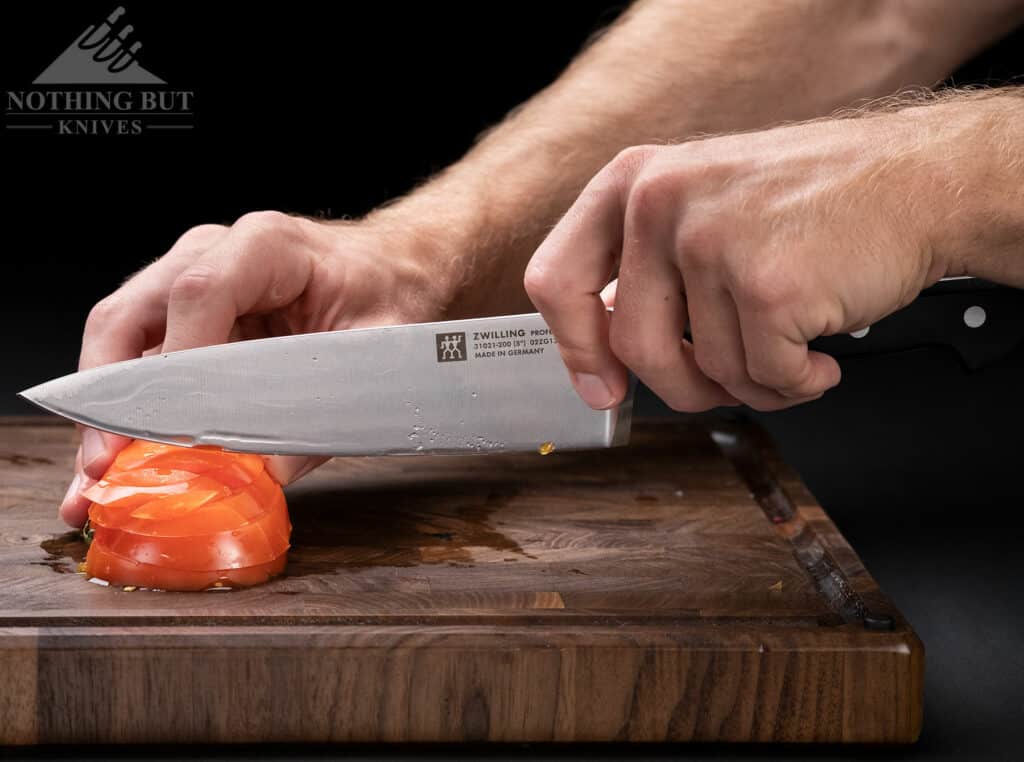
The story I heard is that Peter Henkels trademarked the Zwilling and Henkels names in the month of June, which makes the company a Gemini on the Zodiac calendar. The symbol is supposed to represent twin strongmen.
The word “Zwilling” also means “twin” in german, which means the names of knives like the “Zwilling Twin Fin II” translates to the “Twinning Twin Fin II”, and I can not stress enough how important it is that you say that out loud to yourself at some point.
What is FRIODUR steel?
This is a tricky one. They list a lot of their knives as having “Friodur steel”, but when I talked to someone in Zwilling directly they explained it as a “patented process where the steel is dipped more than once into extremely cold temperatures to make the steel harder and more stain resistant”. That essentially describes a very thorough cryo treatment, not a steel formula.
But ambitious forum sleuths argued with each other long enough to decide the steel used in a Henkels 4 Star chef knife is probably something like 1.4116 with a couple of extra twists.
The end result is a tough steel that makes knives last a long time. Zwilling patented the formula for Friodur steel process in 1939 and have managed to maintain a strong reputation for durable knives since then. Whatever the steel and process are, they’re more than good enough for kitchen work.
What is Sigmaforged
This word tends to accompany any knife sporting Friodur treated steel. I can’t work out exactly what the “sigma” part is all about. I also asked Zwilling about this, and they basically described a standard forging process back to me. I’m guessing the term refers to knives being heated to a specific temperature and hammered according to a particular setting, both of which might be treated as some kind of trade secret by Zwilling.
The important part for most of us is that it means a knife has been heated and molded from a single bar of metal, rather than cut from a sheet.
Are Zwilling Knives Made in Germany
Yes, kind of. Almost all Zwilling knives are made in Germany except for a few made in Japan, and a smoattering of budget series from Spain. Zwilling’s other brands are made in a few other countries, though.
Zwilling’s J.A. Henkel’s knives are made in various places including Spain, India, and China. Look for the single strongman on the blade. Two strongmen means it’s a Zwilling knife, and probably made in Germany or Japan. One strongman probably means it was made elsewhere.
Miyabi knives are made in Seki, Japan. Those stand out from Zwilling’s other brands easily knife, but it’s worth mentioning that a few models like the Kramer Carbon series are made in the Miyabi factory and sold as Zwillings.
High End Zwilling Series
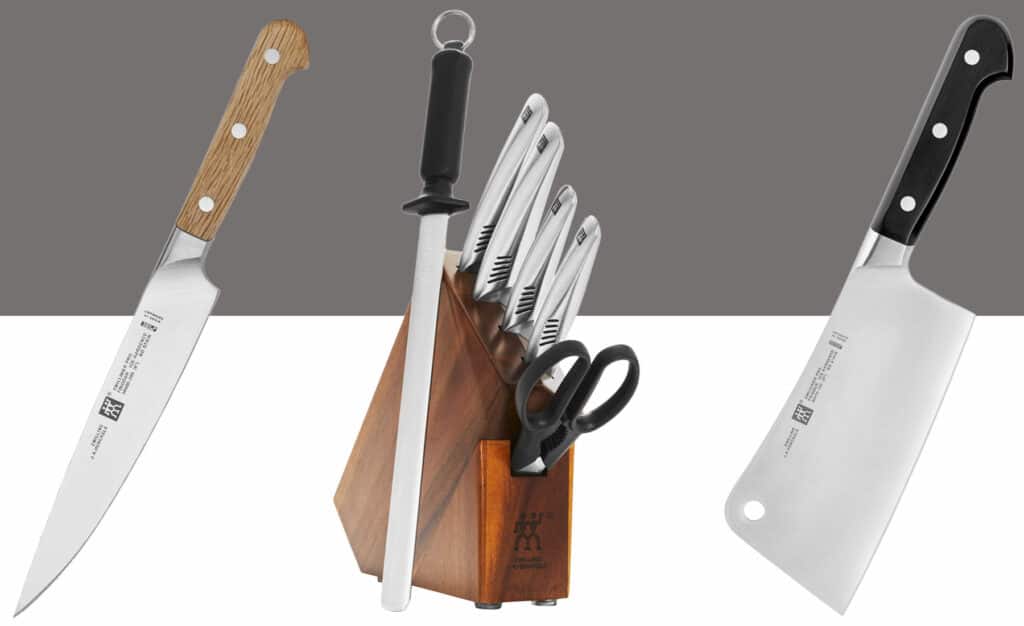
I’ve separated these series by comparing the prices of the 8” chef knives in each one. For the high end section the only requirement I had was for the chef knife to be over the $100 mark as listed on Zwilling’s site. It’s worth keeping in mind that a higher price doesn’t necessarily mean “higher quality” here. A lot of these knives are made with the same materials. Sometimes the price can reflect where they’re made, or something about the shape in the design might make the production process more complicated.
For this section at least, I’d recommend choosing a knife based on how you prefer your kitchen cutlery to look and feel rather than which one might have better steel, because all these knives perform pretty well.
Zwilling Pro
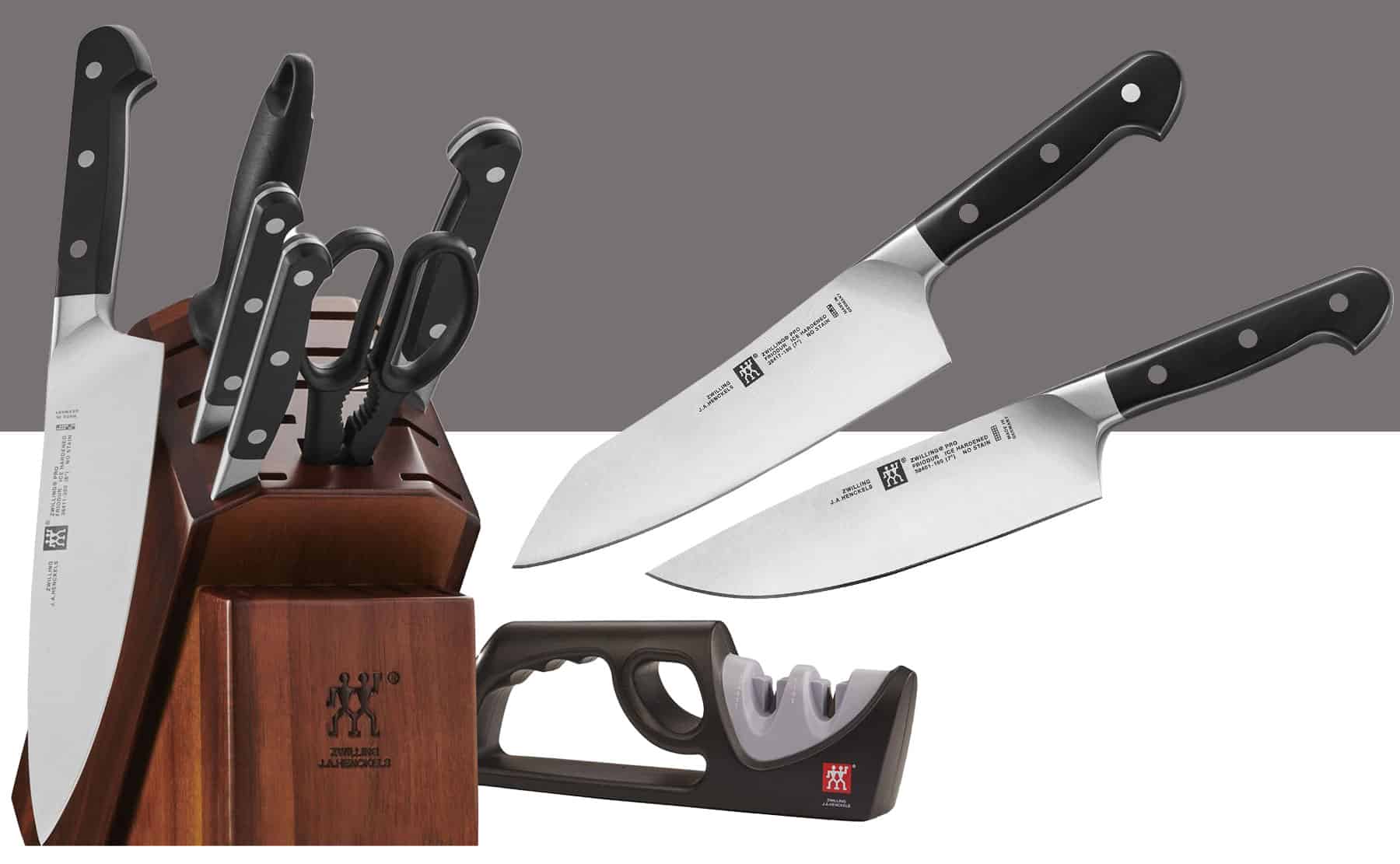
Specifications
| Made in Germany |
| Polymer three-rivet handles come in black and white |
| Full tang |
| Sigmaforged Friodur steel |
| Curved half bolster |
| Fits Pro block sets w/ angled slots |
| Price of 8” Chef knife: $160 |
This is one of Zwilling’s bread-and-butter designs. Generally when I recommend a Zwilling knife to people, it’s from the Professional series. And when I talk about other chef knives (including other Zwilling knives) I tend to use the Pro series chef knives as a benchmark.
They’re one of the best examples of a traditional western knife both in terms of basic design and robust reliability. They also fit very neatly into a category that’s both high functioning and reasonably priced compared to a lot of other big-name brands.
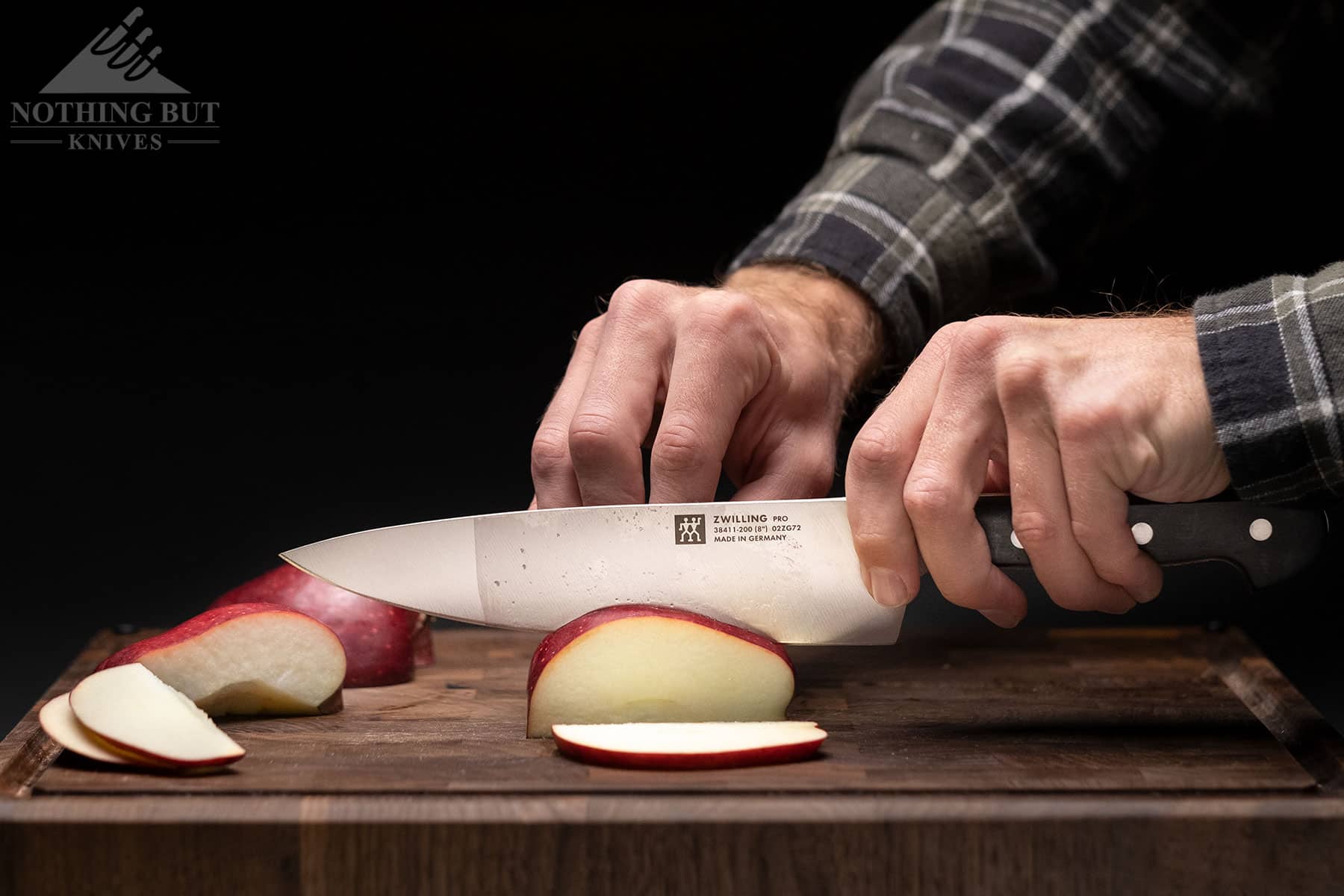
If you’re in the market for a full block set, this is absolutely the best series to go with, because Zwilling offers this in a half dozen different kinds of blocks and block sizes ranging from massive 20-piece sets that make your countertop look like the back end of a missile cruiser to a more economic, vertically-oriented ceramic blocks that max out at 6 pieces.
We liked the Professional S series enough to include it in our Best Professional Knife Sets article. If you would like to learn a little more about the performance of this knife series check out our Zwilling Professional S Chef Knife Review.
Knives Available in Pro Series
| 8” Chef’s knife | 8” Carving knife |
| 8” Chef’s knife traditional | 7” filet knife |
| 7” Chef’s slim knife | 9” bread knife |
| 7” Chinese cleaver | 8” bread knife |
| 7” Rocking Santoku | 4” paring knife |
Zwilling Pro Slim
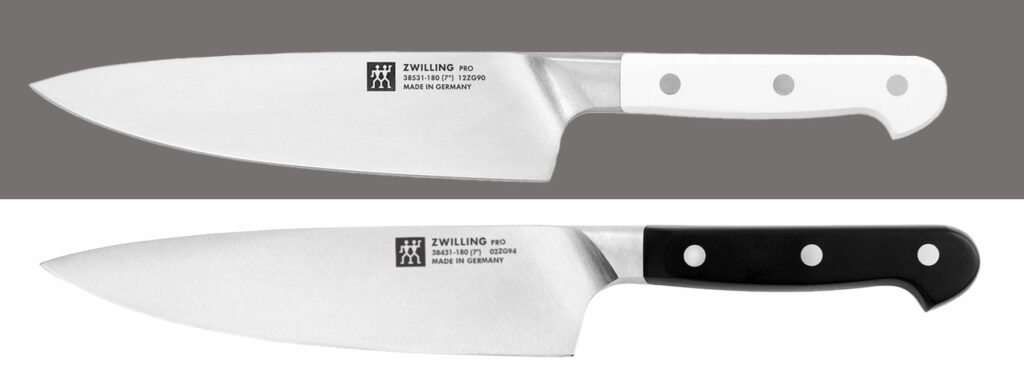
Specifications
| Made in Germany |
| The lightweight version of Zwilling Pro knives |
| Generally about 24% lighter than Pro designs |
| Thinner handles, slimmer blades |
| Fits all the Pro blocks w/ angled slots |
Zwilling is playing with a lot of variation in this series right now, so on top of making these knives in white and black, they’ve also started making “Slim” versions. These have essentially the same profile, but less material. The handles are a little smaller, and the blades are thinned out to reduce weight. This is a really good way to go for people with smaller hands, or just want a lighter knife.
One of the big features of Zwilling knives over the years has been their big handles. That’s been both a warning and a promise for different cooks, so it makes a lot of sense for Zwilling to reorient one of their best designs for people who don’t have giant mits.
The prices are about the same for Pro Slim knives, which seems a bit suspicious since you’re paying for elss material, but keep in mind that the design and the craftsmanship are the big pulls here. The steel and plastic handles probably don’t bump the price of manufacturing all that much in this case.
Knives Available in Pro Slim
| 7” Chef’s Slim knife (black and white handle) |
| 7” Hollow Edge Slim Santoku (black and white handle) |
Zwilling Professional S
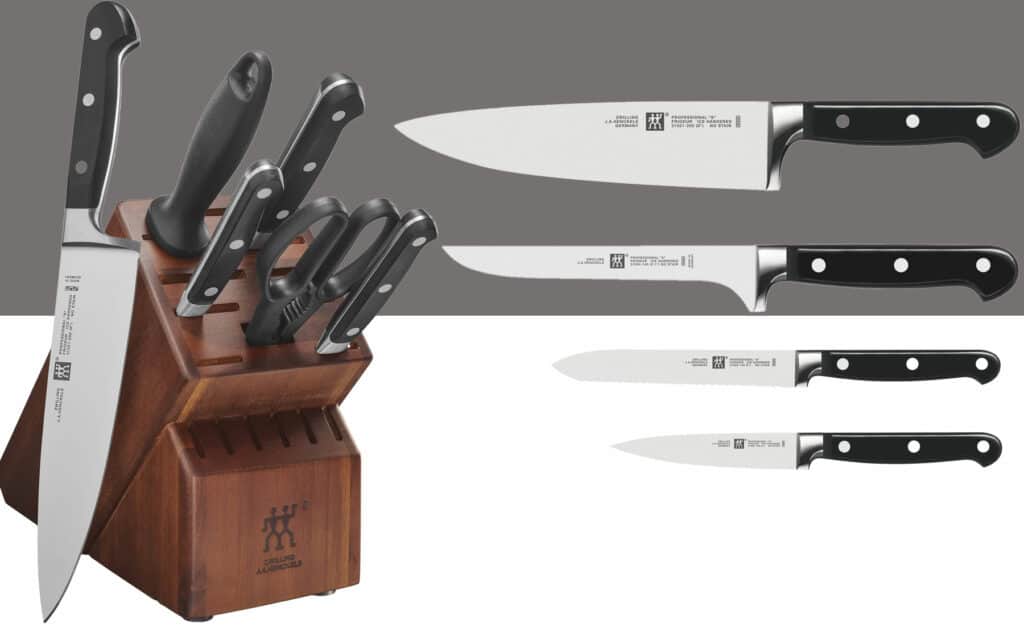
Specifications
| Made in Germany |
| Polymer three-rivet handles |
| Sigmaforged Friodur steel |
| Full flat bolsters |
| Fits all blocks with flat slots |
| Price of 8” Chef knife: $160 |
The Pro S series feels like the consolation set. All the knives in the Pro S line up are essentially the same as those in the Professional line up except for the full bolsters, and they aren’t available in white handles.
The blade shape is also a little different. The Pro S chef knife tapers more on the spine so you end up with a point that’s more forward facing where the spine on the standard Pro is straighter and puts the point more in line with the back of your hand. It’s a minor difference that most people don’t care about, but it’s worth noting if you do a lot of work with the tip of a knife.
On the whole I prefer the Professional series, but apparently everyone feels that way, because those are out of stock all the time. When the Zwilling Professional stuff is out, though, the Zwilling Pro S is waiting patiently in the corner for you to admit to yourself that you don’t hate bolsters that much.
Even with bolsters, these are good knives. The balance is nice, and they cut and cost the same. It’s just a little harder to sharpen the whole edge, and a little more awkward to hold the chef knife in a pinch grip. Past that, these are perfectly fine, and you can usually find the Pro S knives in the same variations of block sets except that the bolsters restrict it to the traditional block design.
Knives Available in Professional S
| 10” chef knife | 5” utility knife, serrated |
| 8” chef knife | 5.5” prep knife |
| 6” chef knife | 4.5” steak knife |
| 7” hollow edge santoku | 5.5” flexible boning knife |
| 5.5” hollow edge edge santoku | 4” paring knife |
| 12” salmon slicing knife | 3” paring knife |
| 8” slicing/carving knife | 2.75” vegetable knife |
| 7” fillet knife | 2.75” bird’s beak peeling knife |
| 6” utility knife | Sharpening steel (10-12”, round and oval) |
Zwilling Twin Four Star
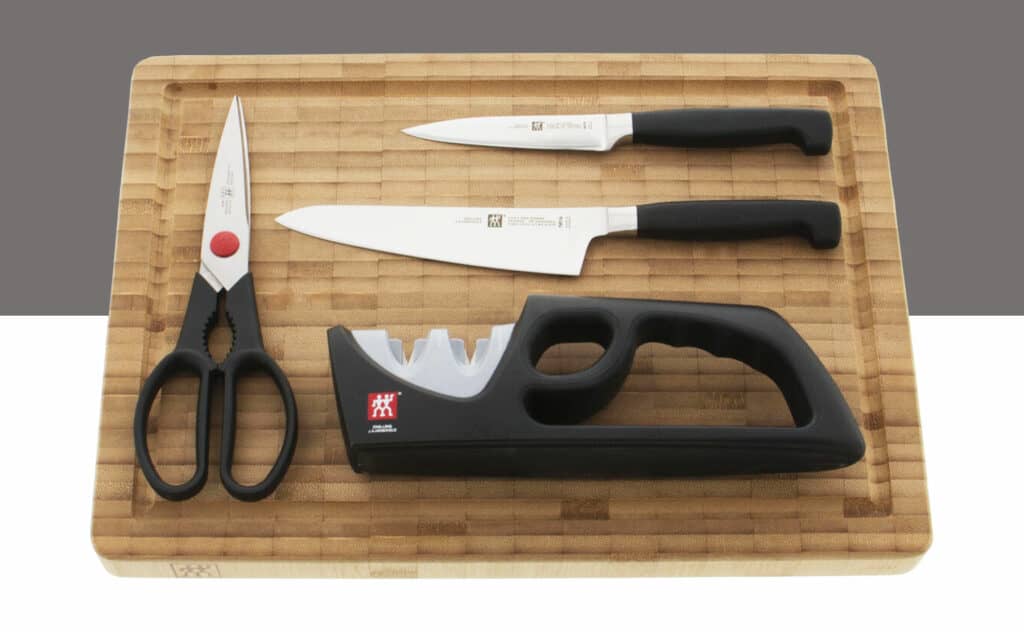
Specifications
| Made in Germany |
| Concealed tang |
| Rounded Polypropylene handle |
| Forged steel at 55 – 58 HRC |
| Full flat bolster |
| 15 degree double bevel edge |
| Fits blocks w/ flat slots |
| Price of 8” Chef knife: $140 |
This is a long beloved design in Zwilling’s history. They came out with this series back in 1976, and it’s been a staple of the company ever since.
It’s one of the cheaper options in their non-budget line up, and the polypropylene handles give these knives a kind of soft feeling in a full grip that you don’t get with harder polymer wood and plastic handles you see in a lot of the other series. There’s also a good variety of knives in the Four Star style that fit well into flat-topped blocks.
Knives Available in Twin Four Star
| 10” chef knife | 5.5” rocking santoku knife |
| 8” chef knife | 6.5” nakiri knife |
| 7” chef knife | 5.5” prep knife |
| 7” santoku | 6” meat cleaver |
| 7” rocking santoku knife | 11.5” slicing/carving knife |
| 5.5” hollow edge santoku | 8 and 10” slicing/carving knives |
| 9” country bread knife | 10” hollow edge slicing knife |
| 8” bread knife | 5.5” flexible boning knife |
| 7” fillet knife | 4” paring knife |
| 6.5” carving knife | 3” paring knife |
| 6.5” chef knife | 2.75” birds beak peeling knife |
| 6” utility knife | 2.75” trimming knife |
| 5” utility knife |
Zwilling Twin Four Star II
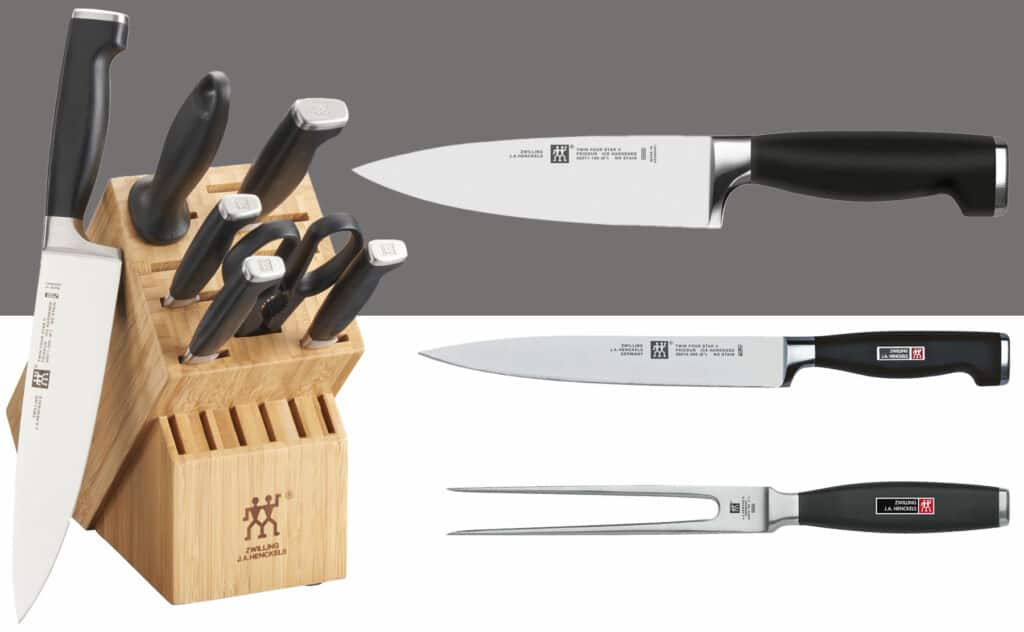
Specifications
| Made in Germany |
| Full flat Bolster |
| Concealed tang |
| 55-58 HRC |
| Sigmaforged Friodur steel |
| Polypropylene handles with stamped end cap |
| Fits blocks w/ flat slots |
| Price of 8” Chef knife: $120 |
This is the Twin Four Star knives again only with an endcap. At least, that’s the main difference I can work out from the original series. This doesn’t make a huge difference, but it will make the knives more handle heavy, kind of like on the Wusthof Ikons (although not that extreme).
I’m not sure where the difference in price comes from, but if you like the Four Star design, this is essentially the same but slightly cheaper, and they should fit all the same blocks. Just keep in mind these will be more handle heavy.
Knives Available in Twin Four Star II
| 8” chef knife | 8” slicing/carving knife |
| 5.5” hollow edge santoku | 5” utility knife |
| 7” hollow edge santoku | 5.5” flexible boning knife |
| 6” meat cleaver | 4” paring knife |
| 8” bread knife | 7” fillet knife |
| 6” chef knife | 6” utility knife |
| 4.5” steak knife | 3” paring knife |
Twin Fin II
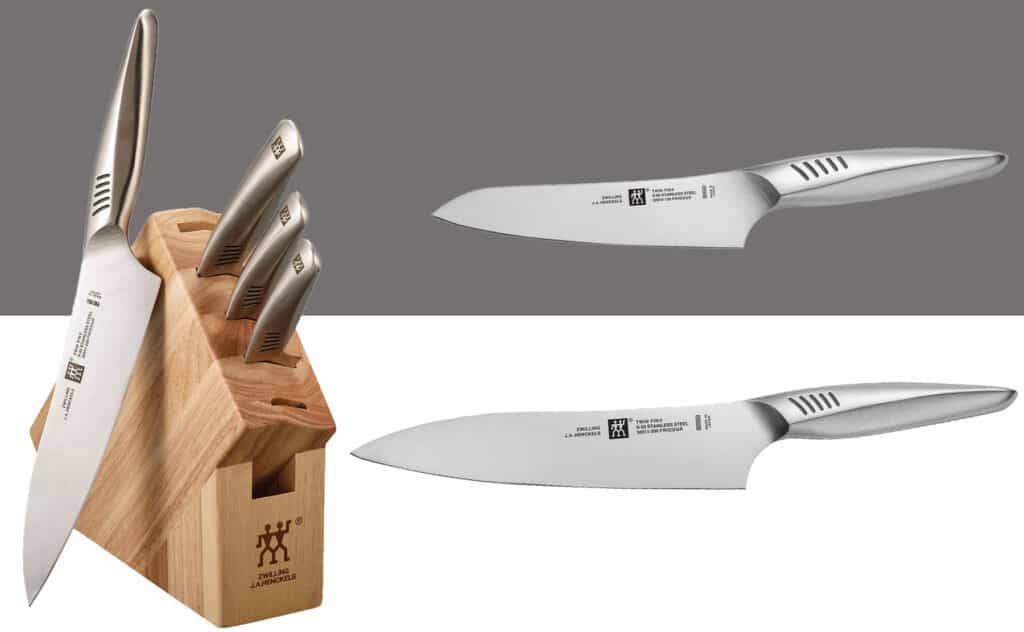
Features
| Made in Seki, Japan |
| N60 steel welded to stainless steel handles |
| Japanese style blades with Hanbazuke edges |
| Handles are gilled for traction and balance |
| Fits Pro blocks w/ angled slots |
| Price of 8” Chef knife: $100 |
This is as cost effective as you’re going to get before this guide dives into the sub $100 range, but that’s not entirely a statement about its quality. This is a unique series in a couple ways.
First, you probably noticed that all-steel make up. That’s actually the least interesting thing about these knives. Although the handles do have some great geometry for pinch grips.
You might have also noticed that “hanbazuke” word referring to the edge of the knives. That’s a sharpening term that traditionally means the knife has only been sharpened to its primary edge, leaving the microbevel to be done by the customer according to their personal use.
I get the impression Zwilling has a slightly different interpretation that can be best described by the “Knife Knowledge” page for Miyabi knives. That’s the Japanese line under Zwilling, and since the Twin Fin line is made in Japan, it’s a safe bet they’re going through the same factory as a lot of Miyabi knives.
The bottom line is these knives should have a really nice, thin edge.
Knives Available in Twin Fin II
| 8” chef knife | 9” slicing knife |
| 7” santoku knife | 8” bread knife |
| 5.5” santoku knife | 5” prep knife |
| 9” kiritsuke knife | 4.5” steak knife |
| 6.5” nakiri knife | 3.5” paring knife |
Zwilling Pro Home Oak
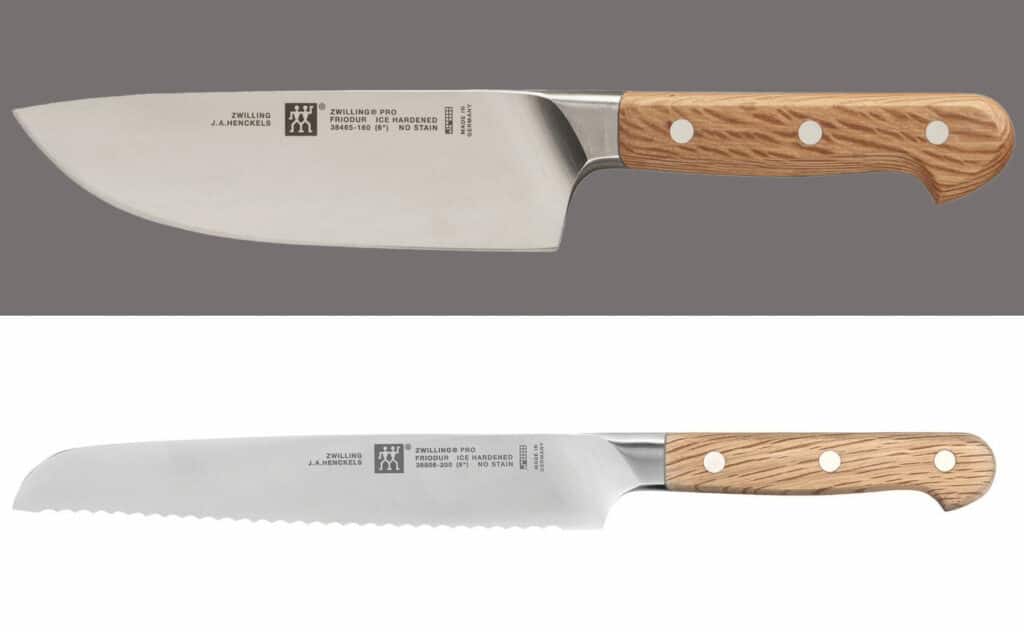
Specifications
| Made in Germany |
| Friodur steel |
| Sigmaforged |
| 55 – 58 HRC |
| Curved half bolster |
| Fits Pro blocks w/ angled slots |
| Price of 8” chef knife: $160 |
This is one of the few Zwilling series with actual wood handles.
It’s a variation of the Zwilling Pro design. All the same shapes and steels are there, but the feel and weight of the handle are going to be a little different by virtue of the natural material. It’s made from holm oak, which is a pretty hard type of wood from the Mediterranean area. I would guess Zwilling is sourcing it from Spain since they have a factory there, but since these knives are made in Germany, it could just as easily be from southern France or Greece.
The important part here is that if you like the Zwilling Pro design, but want something that feels a little more natural, these offer a good option.
Knives Available in Pro Home Oak
| 8” chef knife | 5.5” prep knife |
| 6” chef knife | 10” bread knife |
| 6” carving knife | 8” bread knife |
| 5” utility knife, serrated | 4” paring knife |
| 7” fillet knife | 3” paring knife |
Zwilling Diplome
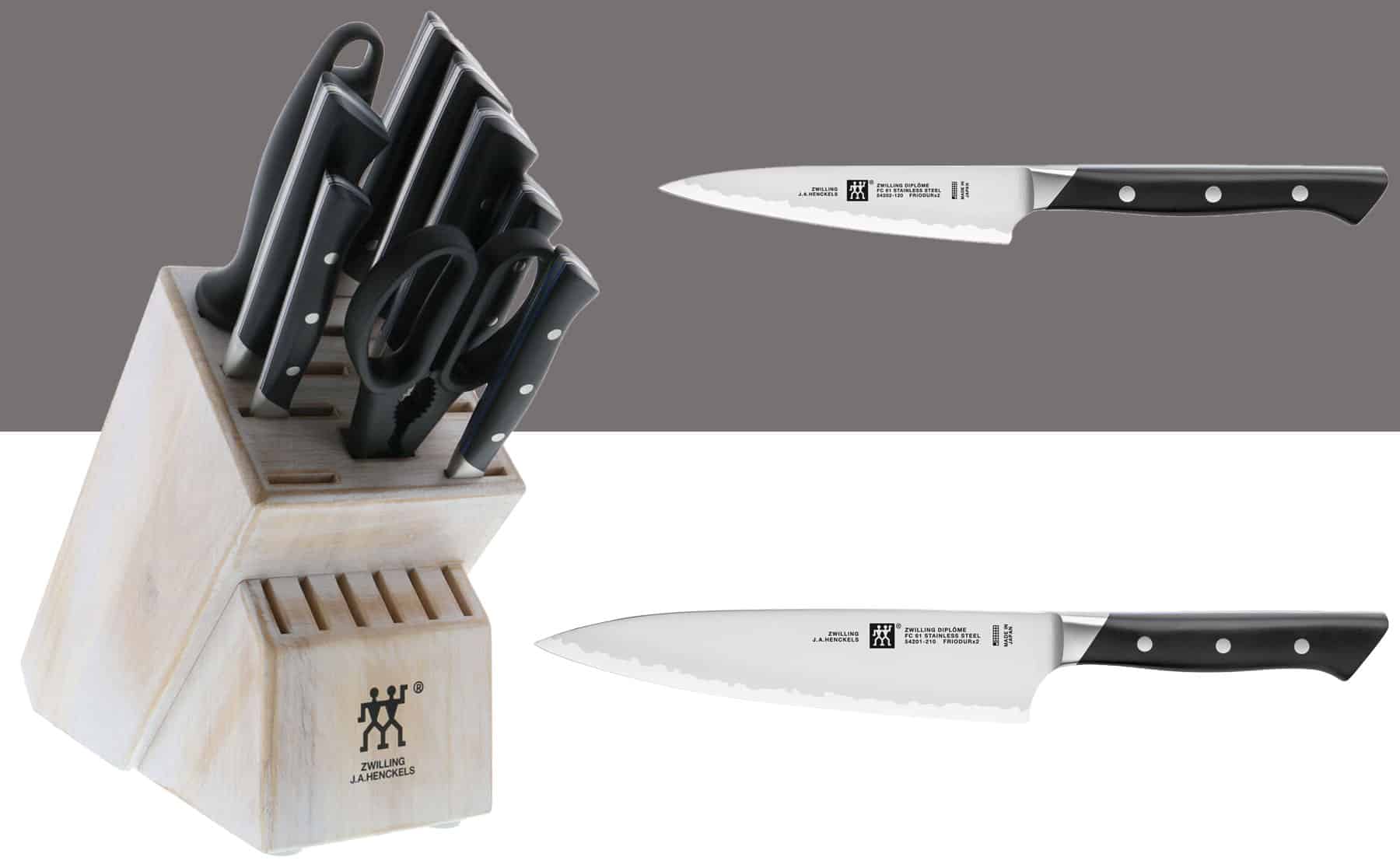
Specifications
| Made in Japan |
| FC61 steel |
| 3-rivet handles w/ plastic scales |
| 61 HRC |
| Hanbazuke style blade w/ 20 degree double bevel edge |
| Japanese style, but French inspired |
| Flat half bolster |
| Fits standard blocks w/ flat slots |
| Price of 8” chef knife: $175 |
These knives were designed in collaboration with chefs from Le Cordon Bleu. That’s probably why the chef knife is more of a gyuto than a traditional German style knife. And also likely why the steel is a lot harder than most of Zwilling’s other knives.
Between the Swedish-made steel and the blocky but minimal handles, the Diplome knives hit a lot of key points that professional cooks are usually pining for. These knives are balanced and sharpened for a long day of getting used repetitively for several hours a day.
This gets into kind of a funny cultural mix up, though, considering these were made for chefs at a French cooking school, but the knives are described as having “Japanese role models” because of the gyuto design. But the gyuto blade shape is an adaptation of the more straight-edged French chef knife. So things have sort of come back around in the Diplome series.
Knives Available in Diplome
| 9” chef knife | 7” fillet knife |
| 8” chef knife | 9” carving knife |
| 7” santoku | 4.5” paring knife |
| 5.5” chef knife, compact | 3.5” vegetable knife |
| 9.5” bread knife |
Zwilling Twin 1731
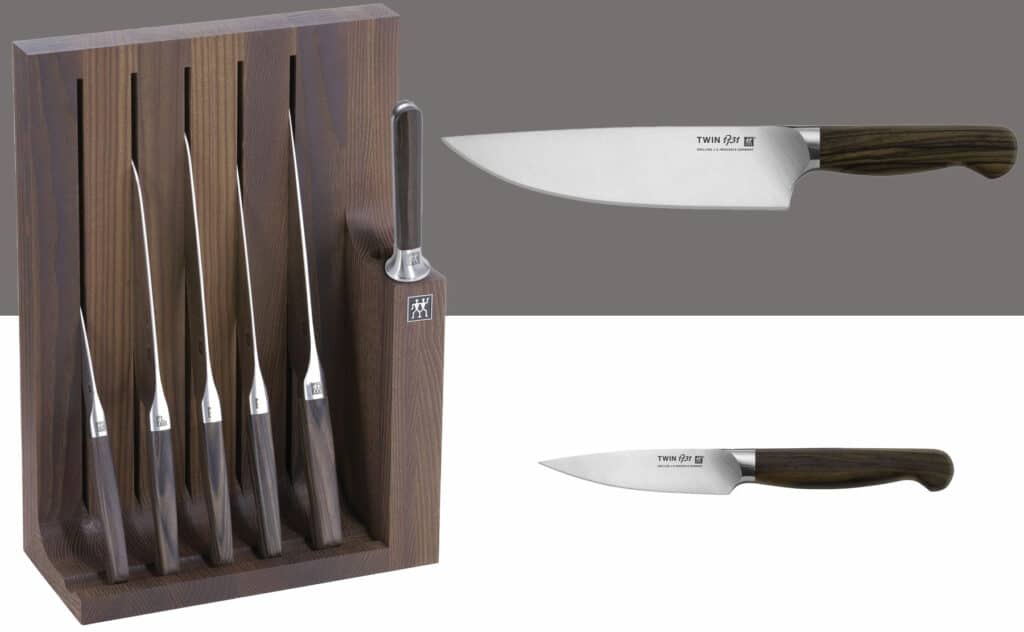
Specifications
| Made in Germany |
| Designed by architect Matteo Thun |
| Ebonywood handle w/ curved half bolster |
| Cronidur 30 steel w/ Friodur cryo treatment |
| Sigmaforged |
| 58 – 60 HRC |
| 12.5 degree double bevel edge |
| Fits standing block in 1731 set, but should work with most standard blocks |
| Price of 8” chef knife: $500 |
If you really want to throw down on Zwilling stuff, the Twin 1731 series is an “all stops pulled” situation.
The handles are made of ebony wood, the steel is cooked to around 60 HRC, and the edge is ground to 12 degrees, so there’s an all around performance upgrade from the Pro series. It was also designed by an architect, which seems like a weird direction to go, but it has resulted in some pretty knives that are incredibly comfortable to hold.
The options of knife types are minimal in this series, but the block set has a nice natural look that hugs the back of a counter well, which makes the full set surprisingly practical in terms of space, if not necessarily price.
Knives Available in Twin 1731
| 8” chef knife | 8” bread knife |
| 7” fine edge santoku | 4” paring knife |
| 8” slicing/carving knife | 9” sharpening steel |
Budget Zwilling Series
This category works the same way as the high end section, just in the opposite direction. All these series feature 8” chef knives that fall below the $100 mark. Except for the series that don’t have chef knives at all, but those still clearly belong in a budget category.
Zwilling Twin Signature
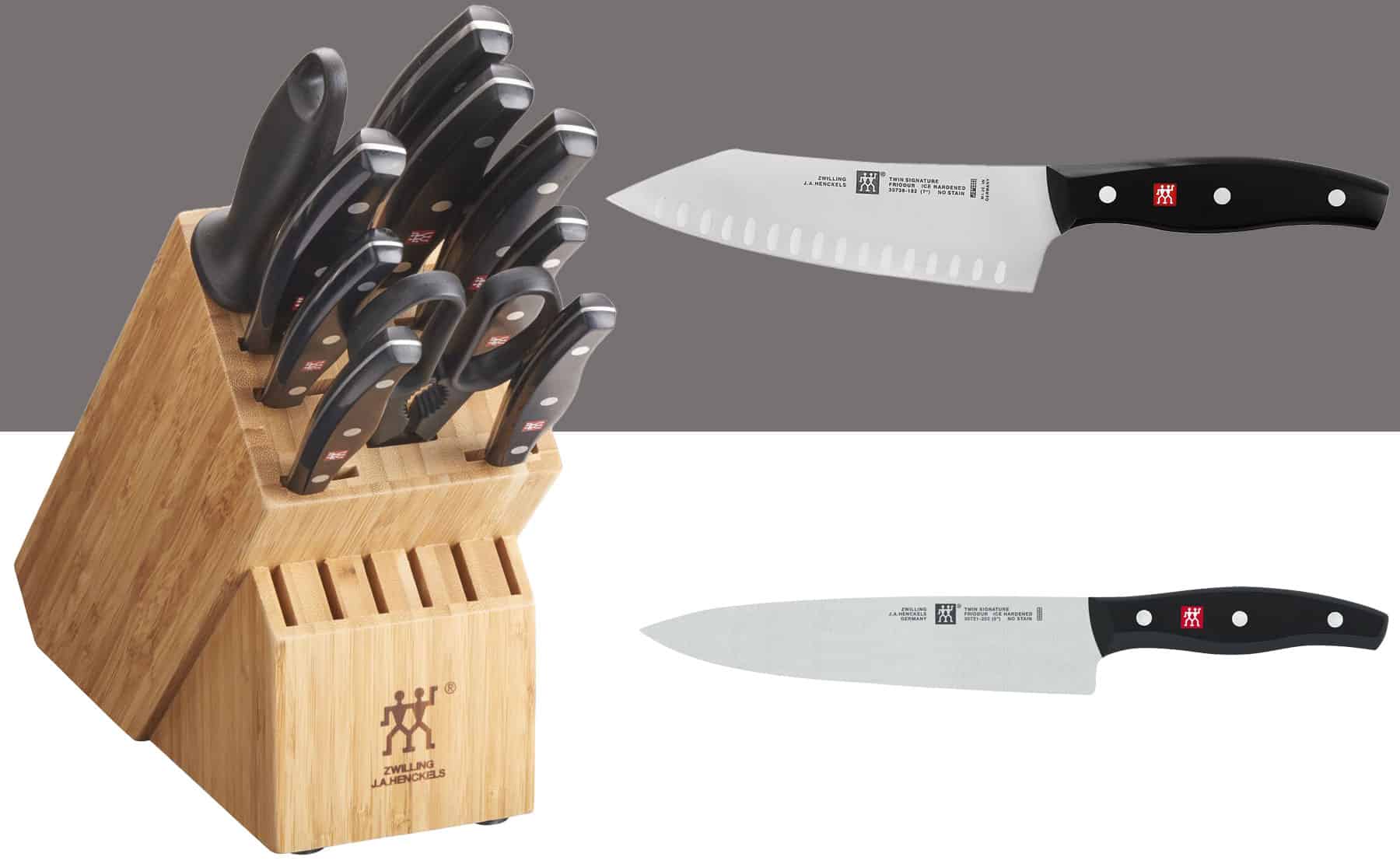
Specifications
| Made in China and Germany |
| Friodur steel with 55 – 58 HRC |
| Stamped blades with 15 degree double bevel |
| Plastic handles |
| Shout fit most standard, flat-slotted blocks |
| Price of 8” Chef knife: $90 |
Of all the budget options for Zwilling, this is probably the most practical and complete (with the arguable exception of the Master series). The Twin Signature stuff could be considered just a step below the Zwilling Pro series by virtue of being stamped instead of forged, and at least partially made in China instead of Solingen, Germany.
I would argue that being stamped doesn’t make that much of a difference unless you plan on jumping up and down on your knives. Past that, the Twin Signature series actually has a slightly thinner blade geometry and about the same hardness, so you should see the same if not better edge retention in them.
There will be a big difference in how the handles feel, though. The swell in the scales on the Twin Signature knives will fill the hand better in a full grip, but they also make the knives a little more handle heavy. It’s a personal preference thing, but the ergonomics on these have been pretty pleasant over the many years that we’ve used ours.
Knives Available in Twin Signature
| 8” chef knife | 8” bread knife |
| 7” hollow edge santoku | 5.5” prep knife |
| 7” hollow edge rocking santoku | 4” paring knife |
| 7” Chinese cleaver | 2.75” birds beak peeling knife |
| 6” utility knife | |
| 5” utility knife, serrated |
Zwilling Twin Master
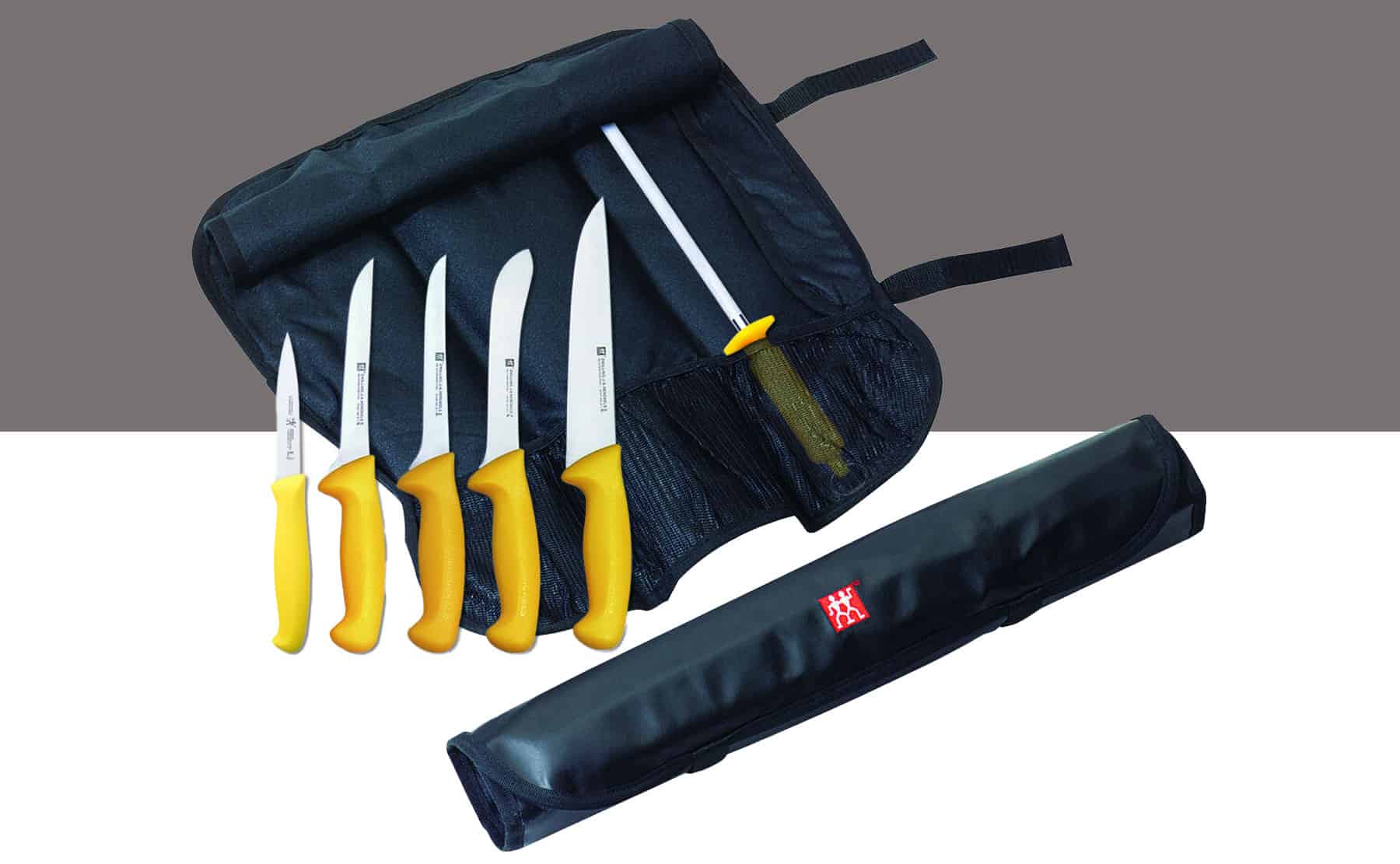
Specifications
| Made in Spain |
| Concealed tang |
| Stamped blades |
| 50 – 54 HRC |
| Plastic handles |
| Fits most standard blocks |
| Price of 8” Chef knife: $50 |
The Master knives are low-cost, no-nonsense knives for the working professional that just needs something that works.
This is the Zwilling equivalent to knives like the Victorinox Fibrox or the Dexter Russel Basics knives. The series features soft steel with plastic handles, and not much more. The knives available in the series fill a practical range that covers pretty much any professional need, including an unusually large variety of boning knives.
It doesn’t look like Zwilling sells these knives in any kind of set, which makes sense since professional cooks and chefs don’t usually buy sets. This is more of a knife roll situation. Find the individual knives you need, pick up a roll, and get to work.
Knives Available in Twin Master
| 9.5” Chef’s knife | 8” Butcher knife |
| 6” flex boning knife | 11.5” Chef’s knife |
| 4” paring knife | 6” stiff boning knife |
| 6” wide boning knife | 9.5” serrated slicer |
| 11.5” slicer | 9.5” pastry knife |
| 9.5” slicer | 2.5” birds beak peeler |
| 8” butcher knife | 3” kudamono knife |
Zwilling Now S
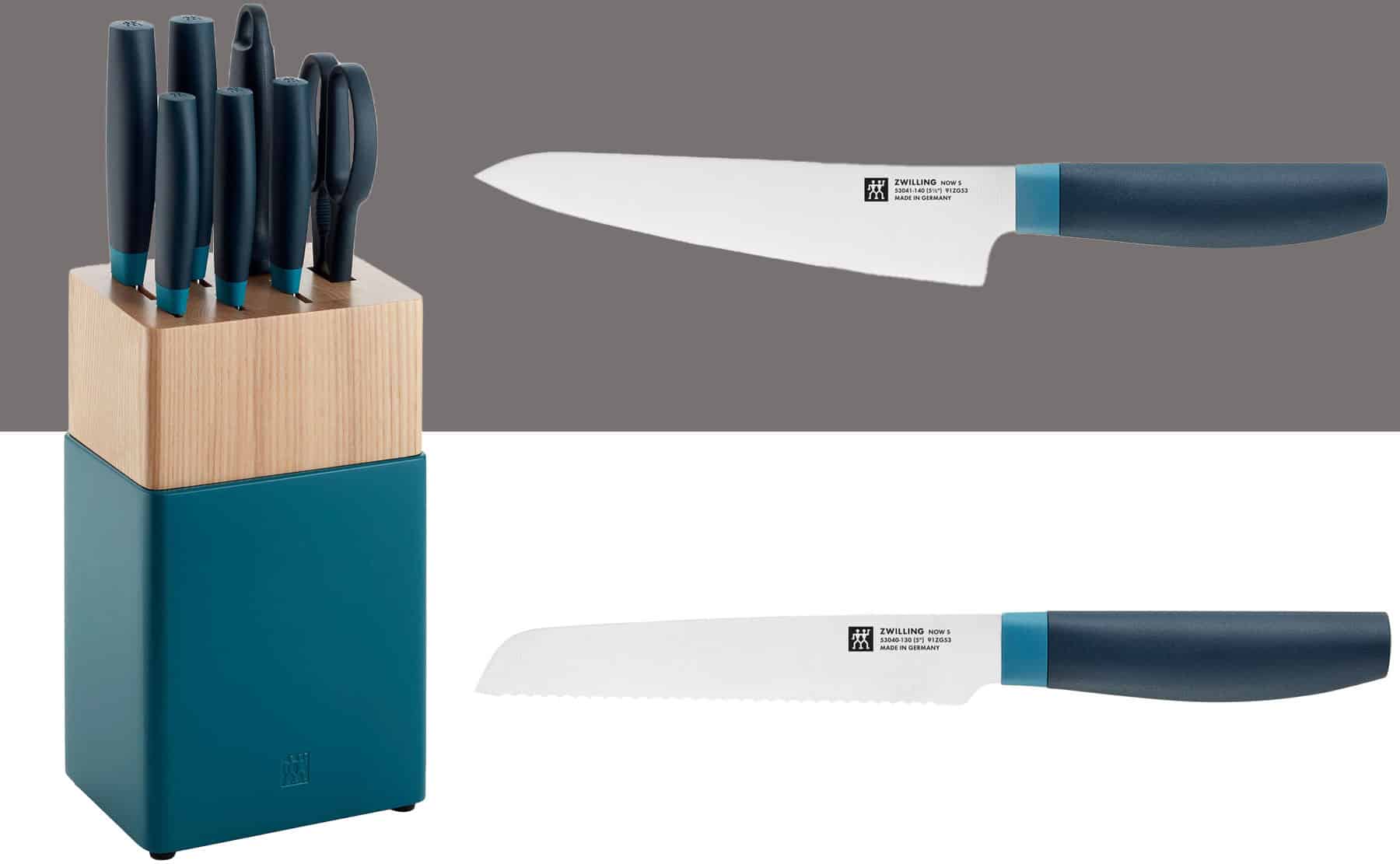
Specifications
| Made in Germany |
| Colorful, bare essentials block set options |
| Concealed tang |
| Laser cut blades |
| 55-58 HRC |
| Polypropylene handle w/ end cap |
| Fits Z Now S block, but should work w/ most standard blocks |
| Price of 8” Chef knife: $60 |
For both space and cost, the Now S knives are probably the most economic choice under the Zwilling name. These knives come in 8-piece sets that sit vertically and take up a pretty reasonable rectangle of counter space. They also come in a larger variety of bright colors if you’re into the whole primary color decoration thing.
Even though these are coming out of the Solingen factory, you have to remember that these are intended to be a budget option. So when you see words like “laser cut” you need to understand that these likely don’t go through the same level of quality control, or held to the same quality standards as even the Twin Signature knives. That’s not to say they’re bad knives, but if you’re used to mid range chef knives, you’re going to feel the streamlined, budget QC in the feel and performance.
The other side of that is for either a $60 chef knife or a $250 set, the Now S knives work really well. They’re comfortable, the steel is decent and easy to sharpen, and if you deign to use one in a restaurant kitchen, you’ll always know which knife is yours.
Knives Available in Now S
| 8” chef knife | 8” bread knife |
| 5.5” prep knife | 5” utility knife, serrated |
| 4” paring knife | Shears |
Zwilling Gourmet
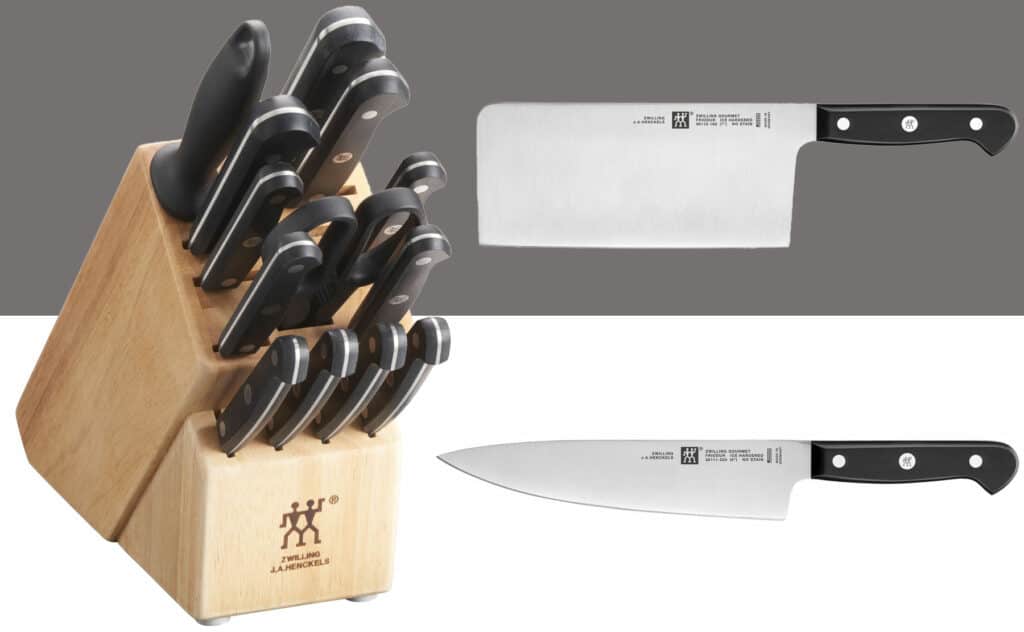
Specifications
| Made in Germany |
| Basic styled series with standard set options |
| POM handles |
| Laser cut blades |
| Friodur steel |
| Fits standard blocks w/ flat slots |
| Price of 8” chef knife: $60 |
These are less colorful than the Now S knives, but they sit in the same price range and they come in a lot more set variations. The handle styling is a little closer to the Zwilling Pro design, but the POM handles will likely feel cheaper and lighter, and they don’t feature the sloped half bolster that cradles the pinch grip.
But when you just need a regular knife that cuts, this is where you go. There are no color frills or super forged blades here. The steel is laser-cut, cryo hardened, and then they slap some POM scales on the tang and send it our way. These knives cut, and they’re comfortable in a very standard way. There’s nothing special to make them especially comfortable, but the design is simple enough that you won’t feel anything actively uncomfortable about them.
One neat thing about them is that, thanks to the scales being flat at the top, the Gourmet knives all fit in the same blocks as the Pro S knives so you can mix and match with that series in a single block if you want.
Knives Available in Gourmet
| 8” chef knife | 6” cleaver |
| 6.5” nakiri knife | 8” bread knife |
| 4” paring knife (plain and serrated) | 4.5” steak knife |
| 5.5” prep knife (plain and serrated) | 3” vegetable knife |
| 2.75” peeling knife | 7” hollow edge santoku |
| 7” fillet knife | 6” slicing/carving knife |
| 10” bread knife | 5” utility knife, serrated |
| 8” slicing/carving knife | 7” Chinese cleaver |
| 5.5” boning knife |
Zwilling Twin Grip
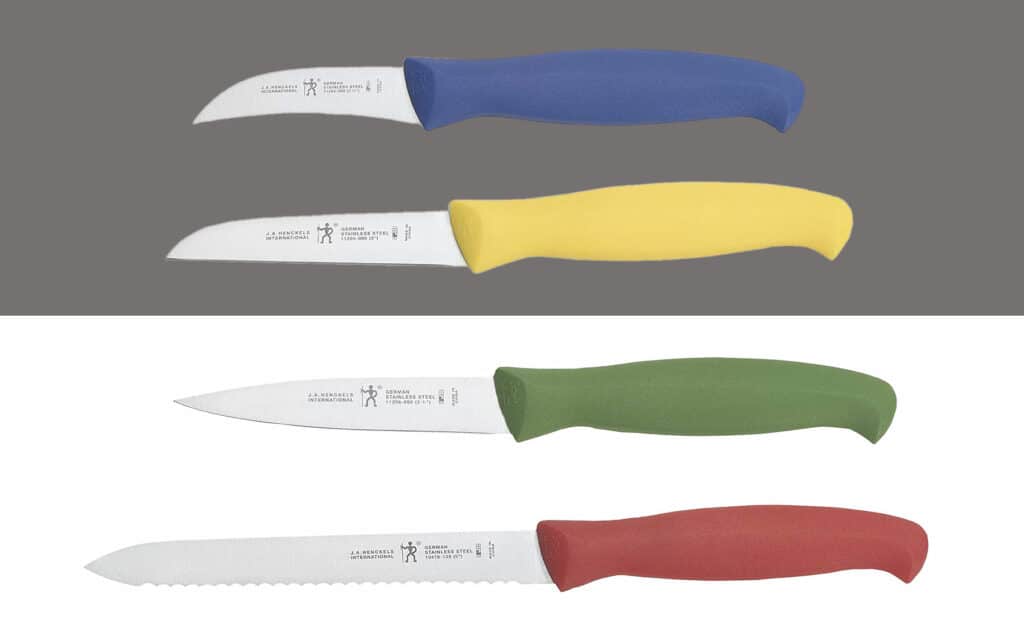
Specifications
| Made in Spain |
| 50 – 54 HRC |
| Plastic handles in several different colors |
| Friodur steel |
| Stamped blades |
| Average price of individual knives: $6 |
You can stop looking for the chef knife in this series. It doesn’t exist, and probably never will. The Twin Grip knives could be said to be the add-on paring knives to the Now S knives because they’re so simple and colorful.
These don’t go in any block, though. They’re just the neat little tools you throw in the drawer or fill out a roll with. You get these either because you need a well-priced paring knife fast, or because you have a very vibrant color scheme in the kitchen that you’re adamant about sticking to.
Outside the fact that these are made in Spain and come in a lot of colors, there’s really no major selling point here. The Twin Grip knives function just barely as well as they need to, but they’re also one of those little things that last forever because, edge geometry aside, they have a comparable build to a Tonka toy.
Knives Available in Twin Grip
| 3” vegetable knife |
| 4.5” utility knife |
| 3” paring knife |
| 3.5” paring knife |
Zwilling Kramer Lines
This is the grail portion of the guide. These are Kramer-designed knives made in Zwilling’s Japanese factory, and they are all, without exception, beautiful, high-performing tools.
You can buy some of these in sets, but none of them come in blocks. Also, Zwilling has been having trouble keeping a lot of these knives in stock. That makes sense since these are labor intensive designs that take a lot of material, but keep in mind that if they’re available at any point, these are not the kind of knives you can sleep on and expect to order a week later.
Check out our in-depth review of the Zwilling By Kramer Essential Collection chef knife to see how this knife series stacks up against the competition.
Zwilling Kramer Euroline Carbon
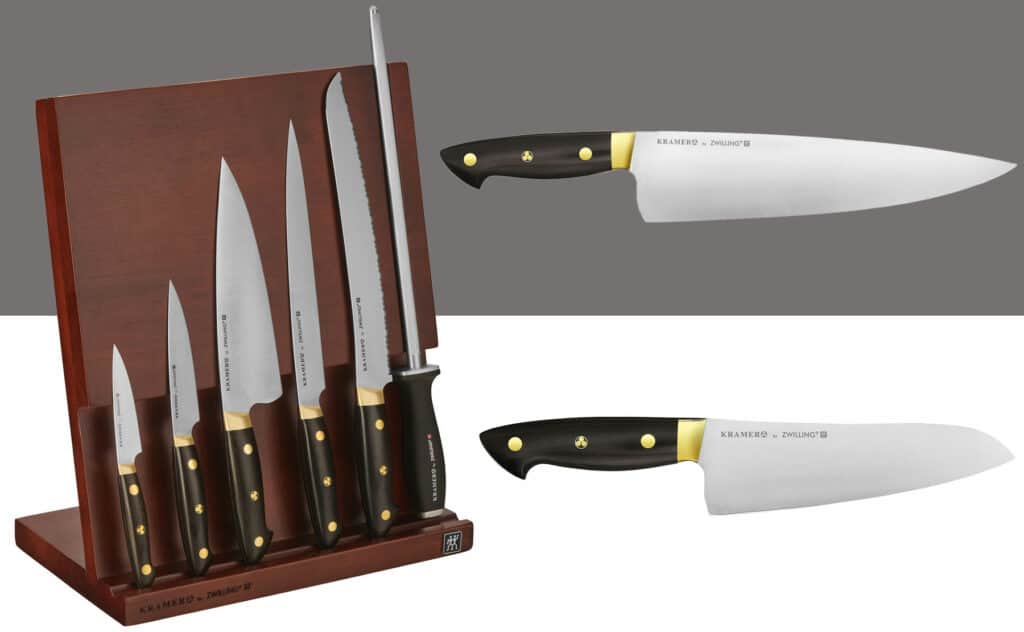
Specifications
| Made in Japan |
| Micarta or Grenadile wood handle |
| 52100 steel |
| 61 HRC |
| Price of 8” chef knife: $300 |
Bob Kramer and Zwilling dropped this line of knives on the kitchen cutlery world a few years ago and damn near made a black hole singularity from the density of people converging on stores to buy one. It made available a certain tier of knives on a production scale that otherwise never would have existed, and while these knives aren’t touched personally by the hand of famed designer Bob Kramer himself, they are his design and they match his specifications for the project.
Functionally these are thick-handled knives optimized for a quick kitchen work flow. They’re comfortable and quick cutting, with tall blades for good knuckle clearance, and a carbon steel that’s pretty famous among custom makers for its ability to take an amazing edge.
They are very much not the most cost effective knife you can get for the kitchen, but they easily one of the most impressive knives you can get for the kitchen before you start getting into territory that has you paying thousands of dollars for a single knife.
Knives Available in Kramer Euroline
| 10” chef knife |
| 8” chef knife |
| 6” chef knife |
| 7” santoku |
| 9” slicing/carving knife |
| 9” bread knife |
| 5” utility knife |
| 3.5” paring knife |
Zwilling Kramer Euroline Stainless Damascus
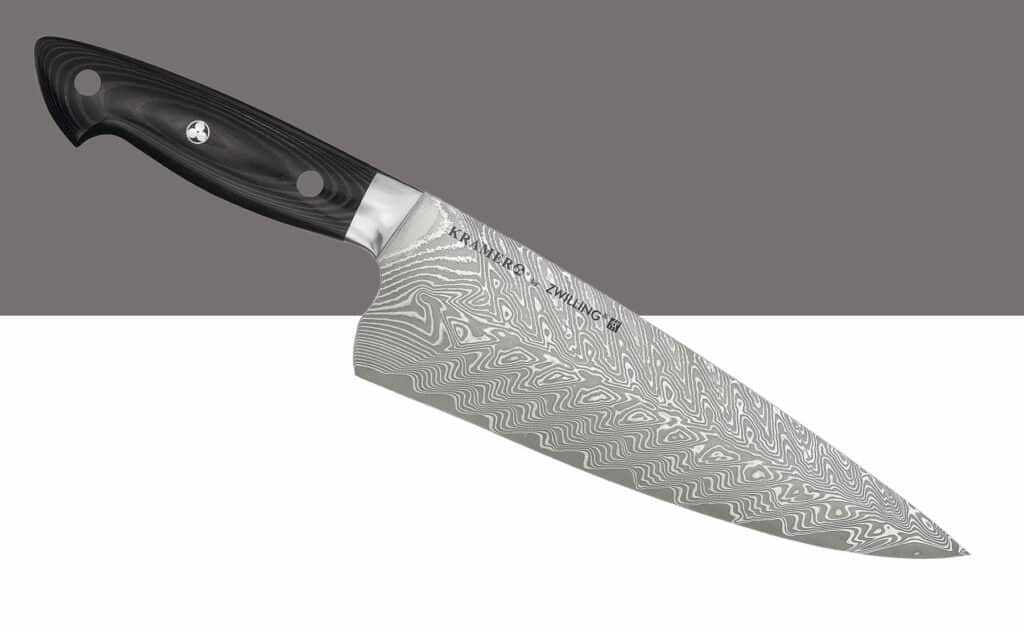
Specifications
| Made in Japan |
| 101 layer Damascus steel w/ SG2 core |
| 9 – 12 degree double bevel edge |
| 63 HRC |
| Micarta handles w/ exposed tang |
| Price of 8” chef knife: $430 |
These knives have all the same lines as the Kramer Euroline Carbon Steel knives, but they’re updated with a Damascus steel that uses SG2 as its core. The Damascus part is not strictly speaking a performance upgrade, although this will be more rust resistant than the 52100 carbon steel in the original Euroline knives.
However, the SG2 steel specifically makes this a bit nicer. You might see Zwilling refer to SG2 as MC63. You’ll see that a lot in the Miyabi knives (it’s also popular with Shun and Yaxell). The important part is that SG2 is a high hardenable steel with a microcarbide structure, so it has a much more stable structure than 52100 carbon, so the edge retention should be better.
Knives Available in Kramer Euroline Damascus
| 10” chef knife |
| 8” chef knife |
| 8” chef knife, narrow |
| 6” chef knife |
| 7” santoku |
| 10” bread knife |
| 9” slicing/carving knife |
| 5.5” prep knife |
| 3.5” paring knife |
| 5” utility knife |
Zwilling Kramer Carbon 2.0
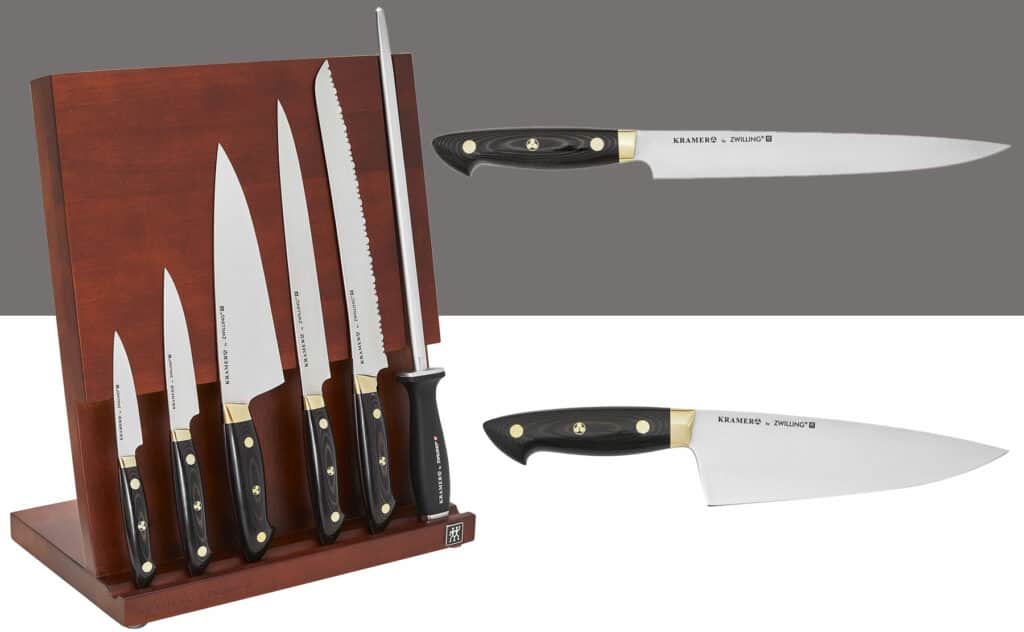
Specifications
| Made in Japan |
| 52100 carbon steel |
| 61 HRC |
| Micarta handles with exposed tang |
| Latest Kramer Carbon series with improved balance |
| Price of 8” chef knife: $350 |
You might have to look twice to catch the relevant differences between the Kramer Carbon and the Carbon 2.0, but they are there. The biggest one is the straightening out of the bottom of the blade from the bolster. That’s going to make the pinch feel a little different and it should make the weight distribution a little nicer for rock chopping.
It’s just stylistically cleaner. If we’re all being honest, that little waver on the bottom of the original Kramer Carbons didn’t really need to be there.
Knives Available in Kramer Carbon 2.0
| 10” chef knife |
| 8” chef knife |
| 6” chef knife |
| 9” slicing knife |
| 7” santoku |
| 10” bread knife |
| 5” utility knife |
| 3.5” paring knife |
Zwilling Kramer Meiji
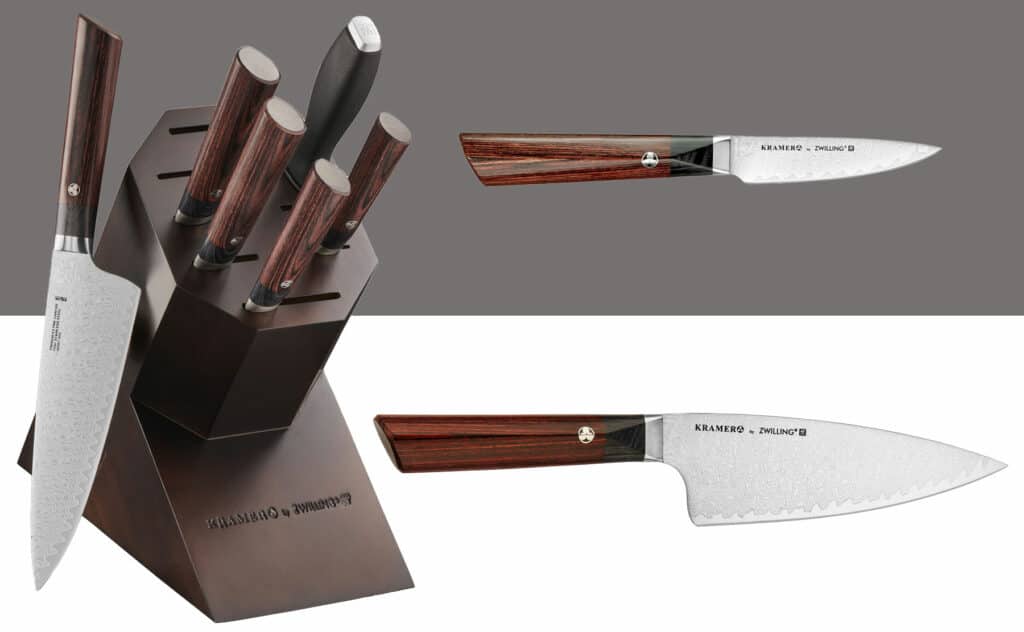
Specifications
| Made in Japan |
| 100 layer Damascus w/ FC61 steel core |
| 60 – 62 HRC |
| Welded blade |
| Pakkawood handles |
| Hidden tang |
| Hanbazuke edge |
| Price of 8” chef knife: $270 |
The Damascus pattern doesn’t tend to show up well on product photos of the Meiji knives, but it’s more pronounced than your typical Amazon listing is actually showing. It’s using a nice, high hardness steel as its core with a layers of nickel wrapped around it, so the Meiji knives are pretty excellent in terms of edge retention and corrosion resistance.
One really important thing to note about these knives is that even though they’re the “Japanese style” Zwilling Kramer knives, they are geared a little more for big handed people. Or, at least, people with larger hands tend to like them more. These won’t be anywhere near as heavy or meaty as the Kramer Euroline knives, but they are generally a little heavier than your typical Japanese kitchen knife. That’s partly because of the wood choice in the handle, and partly because the blade (at least on the chef knife) is a little taller.
Knives Available in Kramer Meji
| 10” chef knife |
| 8” chef knife |
| 6” chef knife |
| 7” santoku |
| 5” utility knife |
| 4” paring knife |
| 10” bread knife |
| 9” slicing knife |
Zwilling Steak Knives
Most of the Zwilling series include steak knife designs, but they have a few one-off series that seem to have been made exclusively for steak knives. That makes organization of this guide tricky, so I’ve opted for the clumsy option and made a whole new section for steak knives.
Toro Steak Knives
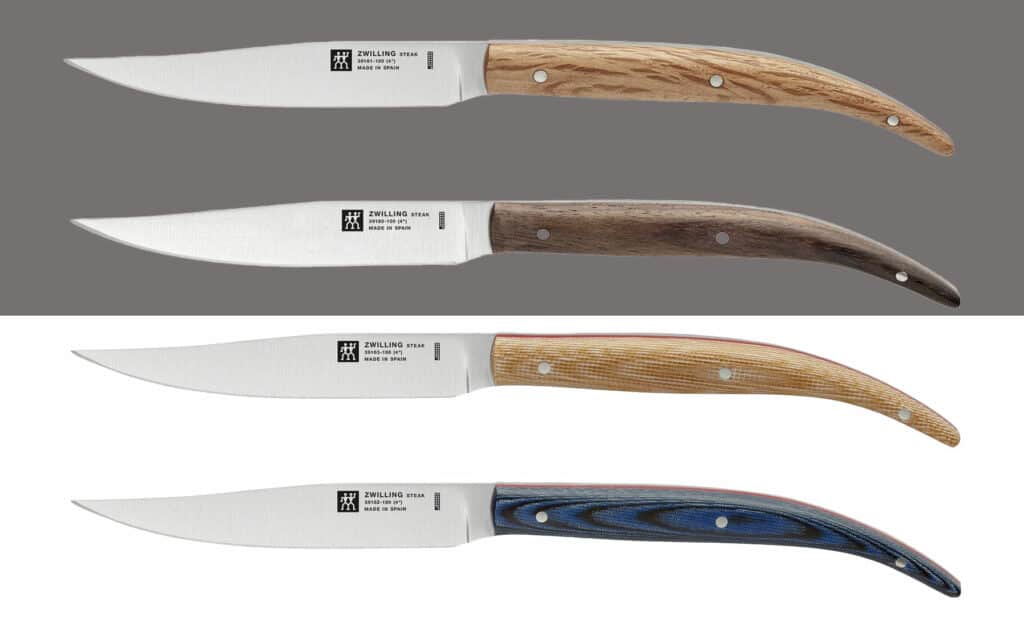
Specifications
| Made in Spain |
| Nitrum Stainless Steel |
| Stamped blades |
| Full tang w/ 3-rivet handles |
| Handle materials: palisander wood, holm oak, and blue linen Micarta |
| Comes in wooden case |
Zwilling has gone the direction of vintage Laguiole knives with the Toro set. You have thinly carved handles with a nice curve at the butt, and a slicey edge with a clip point blade. I’ve heard mixed things about Zwilling’s Spain factory, but I know the design itself is sound concept, and the nitrum steel they use for it is supposed to be pretty hard, so these should have nice edge retention.
I feel like the Toro steak knives pull ahead a lot in terms of looks, though. The handles come in three different materials and colors: holm oak, palisander wood, and linen Micarta. So they’re only different in an understated way that seems appropriate for steak knives.
Steak House Knives
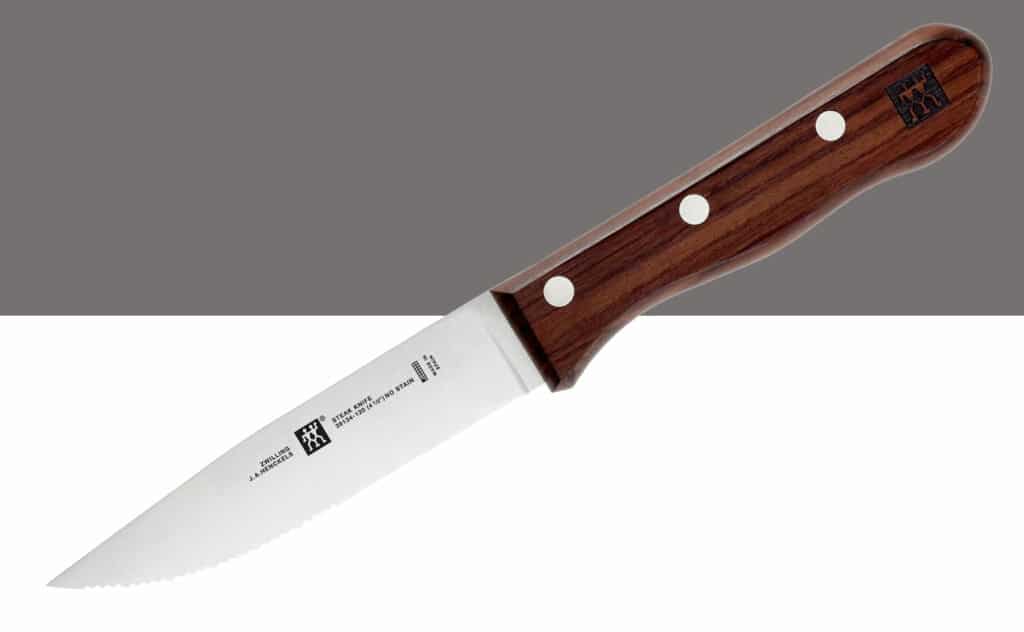
Specifications
| Made in Spain |
| Stamped German stainless steel blades |
| 54 – 56 HRC |
| Inverted serrations |
| Full, exposed tang w/ 3-rivet handle |
| Usually sold as 4-piece set in a wood box |
We’re in a traditional territory here that I think more Americans would be comfortable with: the Steakhouse set has big, fat wood handles and tall blades with serrations along the top curve.
The really unique thing about this set is the inverted serrations, though, which is a difficult element to catch in most product photos. Basically this little feature consists of a line of two types of serrations: larger pieces that are less pointed meant to come in contact with the plate, and smaller, sharper pieces meant to cut the meat. This allows you to cut into the meat and come in contact with the plate without worrying about dulling the edge of the knife. It’s a little gimimck-y, but it’s not a bad solution to a tricky problem where serrated knives are concerned.
Stainless Steel Set
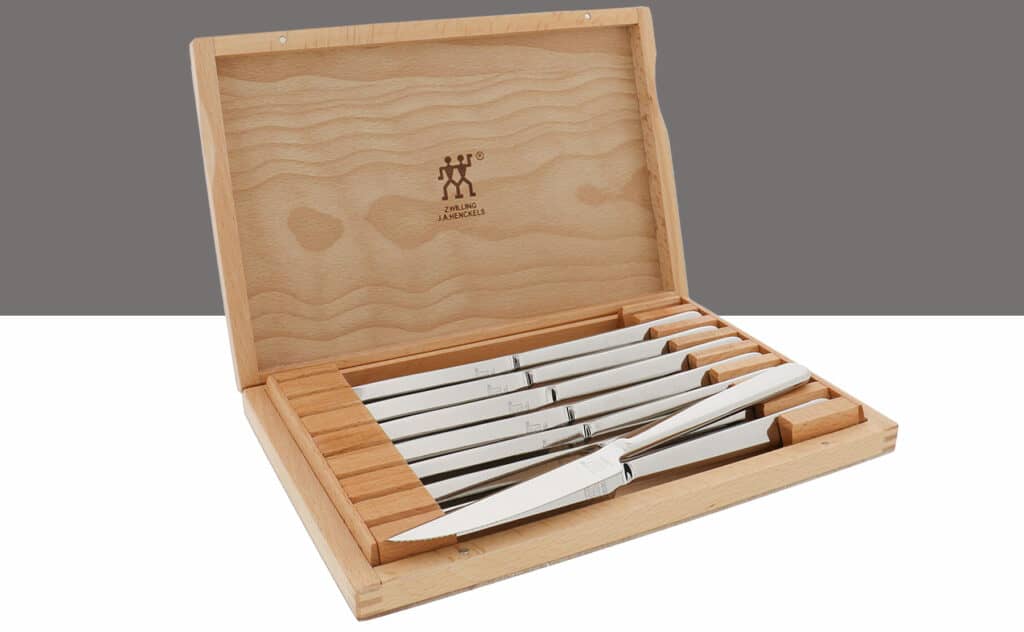
Specifications
| Made in Vietnam |
| Forged high-carbon stainless steel |
| 4.5” half-serrated blades |
| Sold as 8-piece set w/ wood display box |
If you want a high-volume, minimal set, this is a pretty direction to go. The stainless steel set might look like just a step above silverware, but Zwilling makes these knives as single-piece knives forged from what I’m guessing is some kind of 1.4116 German steel.
They have a nice, tapered form if you’re more into light-handed ergonomics, and decent enough serrations that cutting into the meat is fairly effortless. Keep in mind this isn’t one of their high-end, super fine edged designs. It’s meant to cut well enough for a certain price and take up a certain amount of space.
Porterhouse
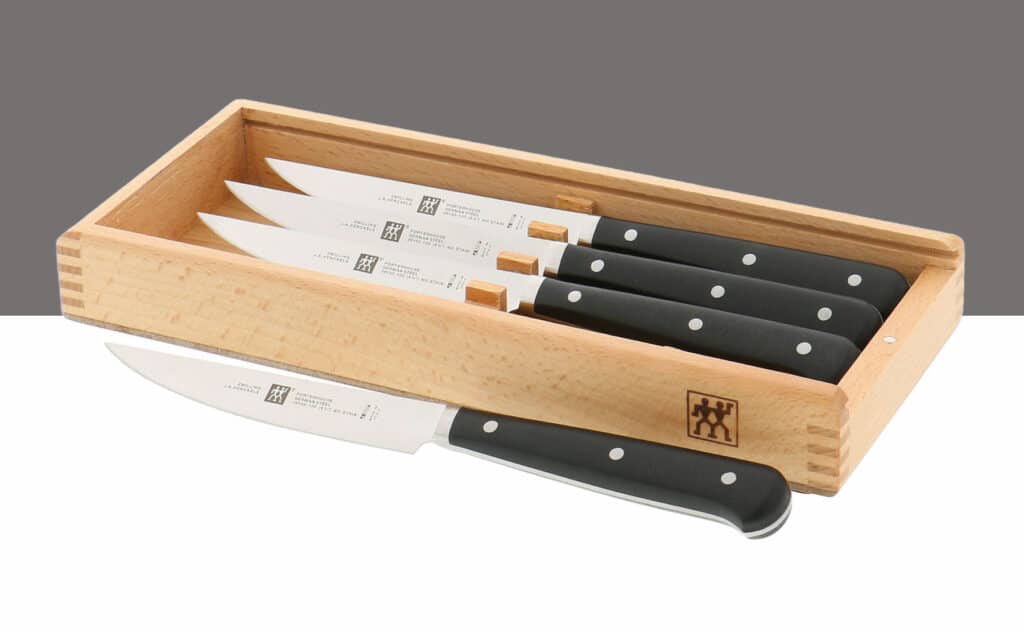
| Black handled: Made in Spain, Stainless Steel: made in Vietnam |
| High-carbon German stainless steel |
| Black handled: plain edge, Stainless steel: half-serrated |
The Porterhouse name gets a little tricky because it looks like Zwilling makes it in two different styles without bothering to differentiate with the name at all:
There’s the stainless steel Porterhouse knives, which are all one-piece stainless steel from handle to blade, and there’s the black polypropylene handled version.
From the looks of it, the stainless steel knives are half serrated while the black-handle knives are plain edge so the choice here isn’t entirely about looks. I won’t pretend to understand the logic behind this line up, but the important information here is that the stainless steel Porterhouse knives have teeth and probably weigh a little more. The black-handle versions might be a little more comfortable and cut a little cleaner.
Gentleman’s Steak Knife Set
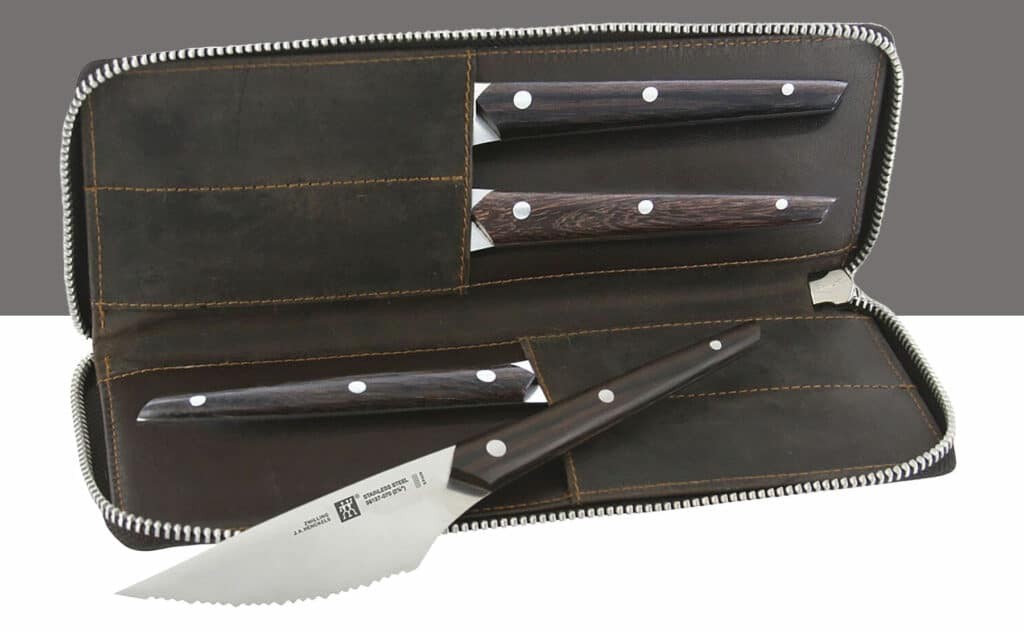
| Made in Spain |
| Stamped German steel blades |
| Full tang w/ 3-rivet handles |
| Inverted full-bladed serrations |
| Palisander wood handles |
Zwilling brings back the inverted serrations with this neat set up. In this case, though, they run the whole blade, and the blade shape itself has a much more dramatic curve. The cutting ergos on these are going to be a bit different from the Steakhouse that’s also sporting inverted serrations. There’s not as much length left on the blade for cutting with, but the tallness of the blade and the extreme curve will definitely give you plenty of pressure and room to cut.
The really neat thing about this set is the travel case, though. It’s a leather pouch with pockets for 4 knives and a zipper so you can throw this in your suitcase and be prepared for a meal anywhere you go.
Stainless Steel Serrated
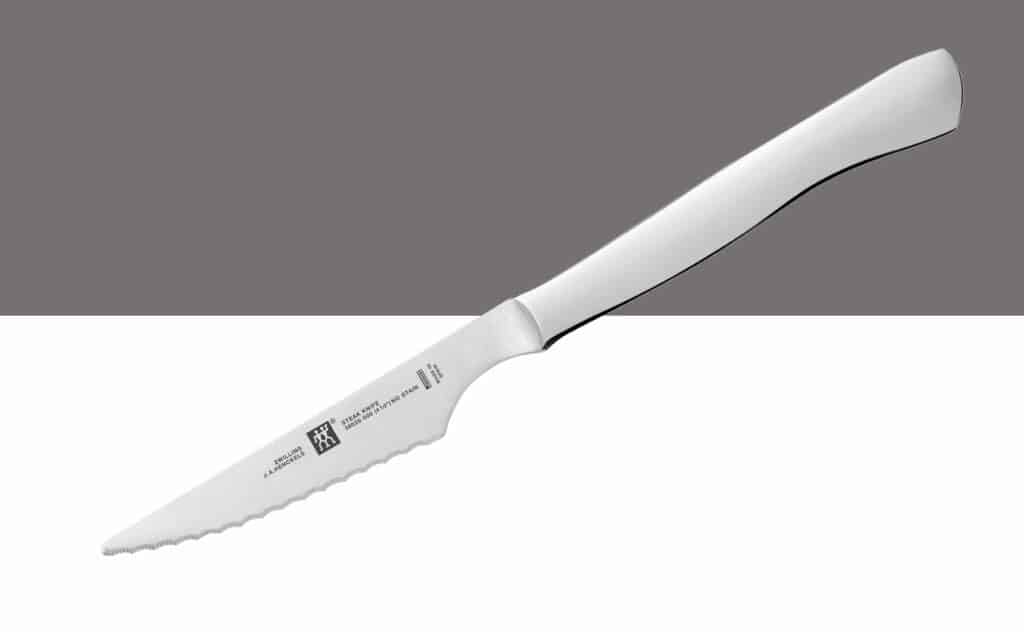
| Made in Spain |
| Stamped stainless steel blades |
| Fully serrated |
Here’s another “stainless steel” set of options for you, just to confuse Zwillings deep category of steak knife sets a little more.
These are very much a budget option. That’s not to say they’re bad, but you need to understand that when you see serrations this wide on a blade this small, you’re not going to get the same kind of quality cutting that you can expect from higher-priced Zwilling options. They get the job done, though, and these definitely have an ergonomic shape you don’t get with any other set.
Bellasera Steak Knives
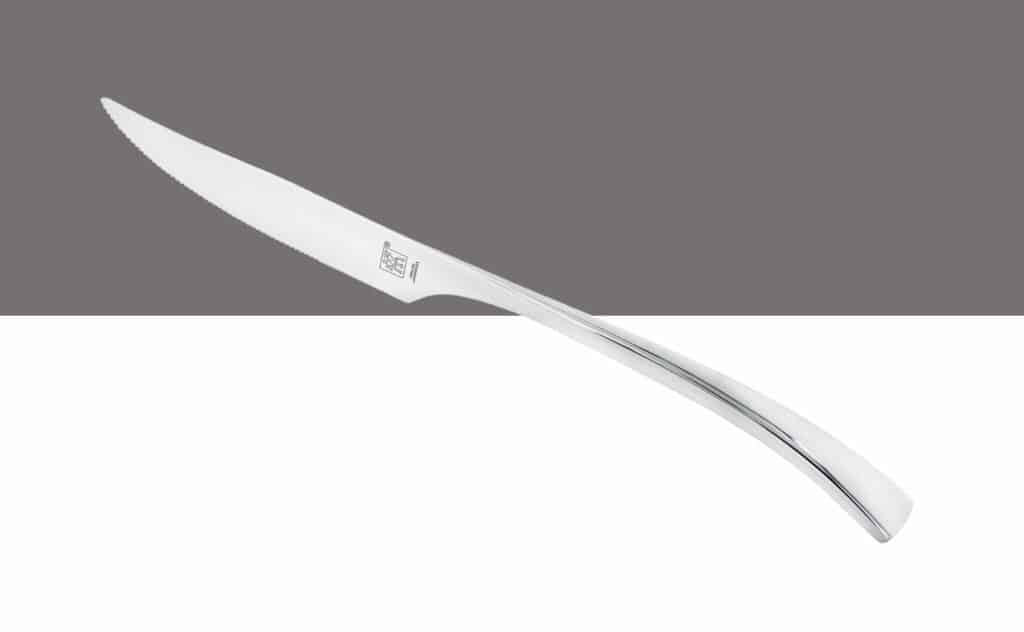
| Made in China |
| One-piece 18/10 stainless steel |
| Good weight and ergonomics |
Again into the budget territory, but this time we’re here with a design that looks a little more dynamic. The Bellasera knives are made from a very high chromium 18/10 steel, so the edge retention isn’t great, but the corrosion resistance is about as good as you can reasonably expect from any knife on your table.
Basically these are a step above butter knives. I very nearly didn’t include them in the guide, but the serrations that Zwilling added to the blade do make these viable as steak knives, and even though they don’t come in a display box of any kind, they do have their own kind of unique look that I appreciate.

A question not really a comment. I have 3 Zwilling 4″ paring knives, 4 star line with the bolsters. Over the years, 25+, routine maintenance and sharpening leaves one with a blade that doesn’t lie flat on a cutting surface because it is impossible to sharpen the knives very close to the bolster. It would be great if I could have the bolster ground down so the full length of the blade could be sharpened. The Pro line has solved this issue. So, are you aware of any service that could accomplish this or do I live with the blade as is or bite the bullet and purchase new knives. BTW, I sharpen using Japanese whetstones. Nice informative review of knives.
You are not alone in having this problem. Most professional sharpeners offer bolster grinding services, so finding one near you would be my first suggestion. They usually don’t charge much, and it’s the safest option for your fingers and your knife.
It is possible to do it yourself, just be sure to tape up the edge and proceed with caution.
If you’re comfortable with a belt sander or angle grinder, the fastest way is to slap the coarsest belt or bit you have on them, grind the bolster down to about about a millimeter from the edge at the front, then taper off the sides from there at about 30 degrees (or whatever looks good to you) until you have that bottom section of cutting edge clear.
You can also do it with a coarse file or sandpaper. It takes a lot of patience, but it’s a lot safer if you’re not used to grinders and power tools.
Whatever you do, keep your nice whetstones away from the bolster. Japanese stones were not made for this kind of bulk work. You will grind them into dust trying to even out the bolster. You can use them to polish the bolster if you want to take off the grind lines after, but don’t use them to take off that much bulk material.
Anyway, hope that helps, Ed. Thanks for reading.
Nicely done guide. Recently I picked up a couple Zwilling Kramer paring knives, the Essential FC61 ($99) and the Zwilling Kramer Euroline Damascus ($219)
The Kramer Damascus is a drop dead gorgeous knife, but it suffered poor quality control, one of the two pins (not the Kramer middle pin) was not ground down and kept slicing my palm. Hard to believe this 100-step knife left the factory.
The Kramer Essential, was perfect in every way. I really wanted to keep the Damascus version, and could have ground down the protrusion being a retired aviation engineer, but returned it.
I’m not one to complain about things, but that fit and finish had me shaking my head.
Definitely weird that a Kramer like that made it out of Zwilling’s Japanese factory. They normally have great QC. Every now and then I’ll hear about someone getting a warped blade, but Zwilling seems to be pretty good about returns.
The FC61 version is definitely one of my favorite knives though. It’s a little big for my tastes, but it’s so comfortable I still like to take it out for a spin every now and then.
Grade-A review. Thanks.
I keep seeing a Zwilling Olymp series set of knives but I never see any of this set ona swilling site. Have you heard of this series or is it a knock-off? Same question with their “Dragon Series” (I live in a country where knock offs have been prevalent )
I mostly just see the Zwilling Olymp cleaver selling anywhere. I’m not sure if they discontinued that series or what. That’s one of the reasons I didn’t include it in this guide.
Zwilling does have a series called Dragon based on Chinese cutlery designs. It came out around 2020. I missed it when I first wrote this guide because it seems to have limited distribution in the US, and I just haven’t gotten around to adding it yet.
If possible could you update the guide for the newly released All*Star line? Thank you! Wonderful information and write-up!
Thanks for the heads up, Badu. We will get it updated.